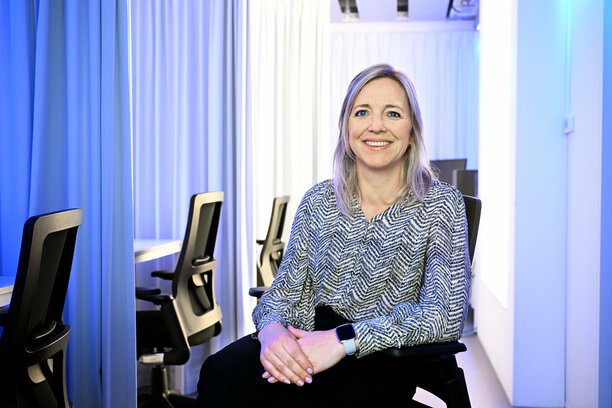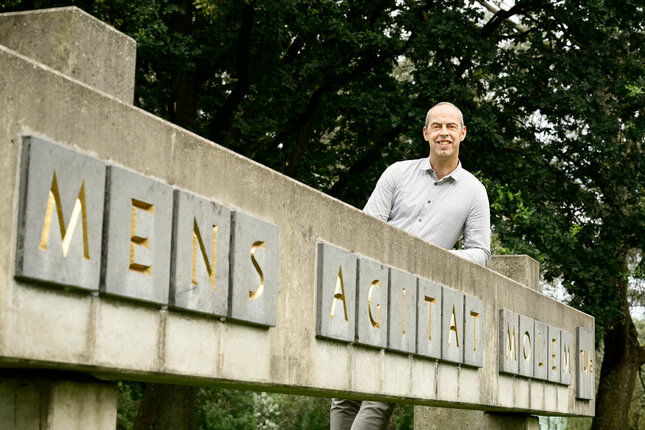From September onward, TU/e scientists will be required to write a biographical sketch as they climb the academic career ladder, reflecting on themselves and their vision in education, research, leadership, and impact. "This provides a nice basis for discussing where you want to go as an academic."
It all began with a pilot at the departments of Mechanical Engineering and Industrial Engineering & Innovation Sciences, but the biographical sketch - also known as the bio-sketch - has now been rolled out TU/e-wide.
This is a new tool developed by our university for assessing and recognizing scientists differently, thanks to Recognition and Rewards.
Five A4s of vision
Starting in September, the university asks scientists who want to step up the academic ladder to write a bio-sketch in preparation for the 'job interview' with the Assessment Committee (benoemingsadviescommissie, BAC).
Candidates use this to reflect on themselves, writing a statement regarding education, research, leadership, and impact and how their time is divided across those domains. And all that within a maximum of five A4s.

Professor Harald van Brummelen is the chair of the permanent Assessment Committee (benoemingsadviescommissie, BAC) of his department of Mechanical Engineering. In this position, he has overseen more than 30 BACs over the past year, during which the candidates used bio-sketch to showcase themselves.
In addition, as the chair of the Engineering Interdepartmental Committee (interfacultaire commissie, IFC), he was closely involved in developing the biographical sketch by Human Resources Management.
What will change with the introduction of the biographical sketch?
"It primarily changes how our scientists can present themselves. In the context of their field, we ask them to showcase themselves with a well-substantiated profile that includes a vision of education, research, impact, and leadership. A fact sheet supports this. 'This is my position, and this makes me unique. This is how I stand out. And I have this track record to back that up,'" outlines Van Brummelen.
In Van Brummelen's experience, "scientists who, in particular, want to profile themselves a little more broadly than in just the research field can use the bio-sketch to express themselves. It provides a nice basis for the conversation on where you want to go as a scientist and how you contribute to TU/e."
Valuable tool
"Instead of simply looking at numbers and the past, how much you've published, and your H-index, look at the person. How can you use what you've done for your future? Nice that you wrote a paper, but what does it mean for you as a scientist? What direction do you want to take with it? That makes the bio-sketch an enormously valuable tool."
'Thanks to the bio sketch, I can show how I add value'
Ramiro Serra experiences the biographical sketch as a big step forward in career development. He was promoted to associate professor-1 at the department of Electrical Engineering. For that assessment interview, he used the biographical sketch to define to which extent he wanted to be rewarded for his teaching and educational efforts, research achievements, and his performance in leadership and impact.
Ramiro Serra is a researcher at the Electrical Energy Systems group. He was among the first in his department to use the biographical sketch for his Assessment Committee (BAC) interview.
In the biographical sketch, scientists reflect by category (research, education, leadership, and impact) on what they have done in the past. And describe a vision for themselves in the future. "For me, that offered advantages because I'm not the archetype researcher," Serra says. He's a passionate teacher and educational innovator in addition to his research. "But it's harder to get proper credit for that."

Ramiro Serra, associate professor at Electrical Engineering
How is a BAC session different with the bio-sketch?
Van Brummelen: "Candidates can expect more questions about their motivation. We want to know what they do, but mostly why they do it. Why did you make that choice? How did you arrive at it? What choices do you still want to make?"
Van Brummelen notes that not everyone has been equally successful in strategically positioning and presenting themselves. "With Recognition and Rewards and the bio-sketch, we are looking more for the personal motivation of our scientists. For some, that may be pure curiosity; for others, an intrinsic desire to solve specific problems. We want to provide more scope for that."
We want to know not only what scientists do but especially why they do it.
Harald van Brummelen, chair of the Engineering Interdepartmental Committee
How have scientists responded to the bio-sketch?
"There is sometimes a bit of reluctance. Some colleagues might feel like they have to jump through another hoop. They've just written a research statement for their previous BAC, and now we're asking for something different with the bio-sketch. It's a change process that takes time, but I believe it will be better in every way than before."
Van Brummelen considers it essential that the biographical sketch not disappear back into a drawer until the next BAC arrives. "This should become an integrated part of our university's career policy. It is not a snapshot but an ongoing process regarding where you are and where you want to go."
'Reflecting on what I've achieved and what my ambitions are is really useful'
At the end of 2023, Karin Smolders presented her biographical sketch to the Assessment Committee (BAC) as part of her promotion process to associate professor 2 (UHD2).
Associate professor Karin Smolders works in the Human-Technology Interaction group within the Industrial Engineering & Innovation Sciences department. She has a background in chronobiology, psychology, and data science, and she is interested in how we can best use technology to monitor and manage health. Her research focuses on the impact of lighting technology on human well-being, health, and performance.
Since February 2024, she's been appointed UHD2. She wrote a biographical sketch to prepare for the necessary BAC interview, highlighting her achievements and ambitions. Her bio sketch outlined how she wants to allocate her time and focus between research, education, impact, and leadership.
She spends about 50% of her time on teaching, 40% on research, and 10% on impact. "It wasn't easy to make that division because tasks are often intertwined, and the division typically varies across quartiles. This is the default, but adjustments are possible," adds Smolders.

Karin Smolders, associate professor at IE&IS
What does the bio-sketch change for members of appointment advisory committees?
"It requires a different mindset. Most BAC members have grown up in a traditional system where the emphasis is on research output. That's no longer the only thing we evaluate because people can also position themselves on education, impact, and leadership."

There is more room for new directions. We all have to get used to that.
Harald van Brummelen, chair of the Engineering Interdepartmental Committee
"The members of the BACs also need to get used to people having more freedom of movement and learn how to assess scientists with broader profiles."
Human Resources Management has developed examples for the members of the BACs. "These are very valuable to us, and I see growth in the BACs," says Van Brummelen.
"We have gained experience thanks to the Mechanical Engineering and Industrial Engineering & Innovation Sciences pilots. This also broadens our assessment framework. Reflection on how a session went is helpful for the next one, even if the candidates are very different."
Flipping the switch
"The members of the interdepartmental committees, in particular, accumulate a lot of experience because they often participate in BACs in different departments and disciplines. We could make some more use of that experience."
Van Brummelen sees that scientists also have to get used to the fact that more diverse career paths are possible thanks to Recognition and Rewards. "You can't just flip the switch and say, 'We're all going to do things differently.' It's a culture shift. They have to get used to being given more scope."
'The beauty of the bio sketch is that you can make it very personal'
Researcher Maja Rücker appeared before the Assessment Committee (BAC) in the spring of 2023 for her promotion to assistant professor-1 (UD1). She participated in the pilot at Mechanical Engineering to use the biographical sketch for this purpose.
Since 2020, Maja Rücker has been researching porous materials at the Department of Mechanical Engineering. In her biographical sketch, Rücker emphasized research, leadership, and diversity.
"I especially want to focus on research because that's where my heart lies. I thrive on my research on porous materials. In my biographical sketch, I wrote how I aim to solve challenges in my field in the future. Such an outlook is difficult to convey in a curriculum vitae. The bio sketch provides space for your ambitions and perspectives on your work and yourself. It goes beyond evaluating based on hard criteria such as the number of publications."
In her bio sketch, Rücker also wrote about her activities that addressed diversity. She started working at TU/e four years ago, thanks to the Irène Curie Fellowship program. In that program, female scientists are given priority when filling vacancies.

Maja Rücker, assistant professor at Mechanical Engineering
What surprised you the most during BAC sessions where the candidates presented themselves using a bio-sketch?
Van Brummelen: "I've seen young people who set out very clear profiles of themselves, which I consider very impressive and central to such a session. The 'why' is at the core. Try to work from a strategic core on why you do something or want to do something and less on the execution and how you want to do it."
As chair of a BAC, Van Brummelen always has a brief conversation with the candidate after the session. "BAC members have enormous experience and can provide useful recommendations and insights. That is often appreciated." In his experience, this also fits perfectly with the approach of the bio-sketch. "The conversation is more about people than a long list of numbers of what they have accomplished. I find that very valuable."






